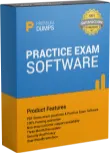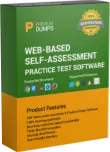
Get Google Professional-Cloud-Architect Exam Dumps
Google Cloud Architect Professional Exam Dumps
This Bundle Pack includes Following 3 Formats
Test software
Practice Test
Answers (PDF)

Professional-Cloud-Architect Desktop Practice
Test Software
Total Questions : 276

Professional-Cloud-Architect Questions & Answers
(PDF)
Total Questions : 276

Professional-Cloud-Architect Web Based Self Assessment Practice Test
Following are some Professional-Cloud-Architect Exam Questions for Review
You are managing several internal applications that are deployed on Compute Engine. Business users inform you that an application has become very slow over the past few days. You want to find the underlying cause in order to solve the problem. What should you do first?
Your company has a Google Cloud project that uses BigQuery for data warehousing on a pay-per-use basis. You want to monitor queries in real time to discover the most costly queries and which users spend the most. What should you do?
For this question, refer to the TerramEarth case study. You are building a microservice-based application for TerramEarth. The application is based on Docker containers. You want to follow Google-recommended practices to build the application continuously and store the build artifacts. What should you do?
You are responsible for the Google Cloud environment in your company Multiple departments need access to their own projects and the members within each department will have the same project responsibilities You want to structure your Google Cloud environment for minimal maintenance and maximum overview of 1AM permissions as each department's projects start and end You want to follow Google-recommended practices What should you do?
You are working with a data warehousing team that performs data analysis. The team needs to process data from external partners, but the data contains personally identifiable information (PlI). You need to process and store the data without storing any of the Pll dat
a. What should you do?
Unlock All Features of Google Professional-Cloud-Architect Dumps Software
Types you want
pass percentage
(Hours: Minutes)
Practice test with
limited questions
Support